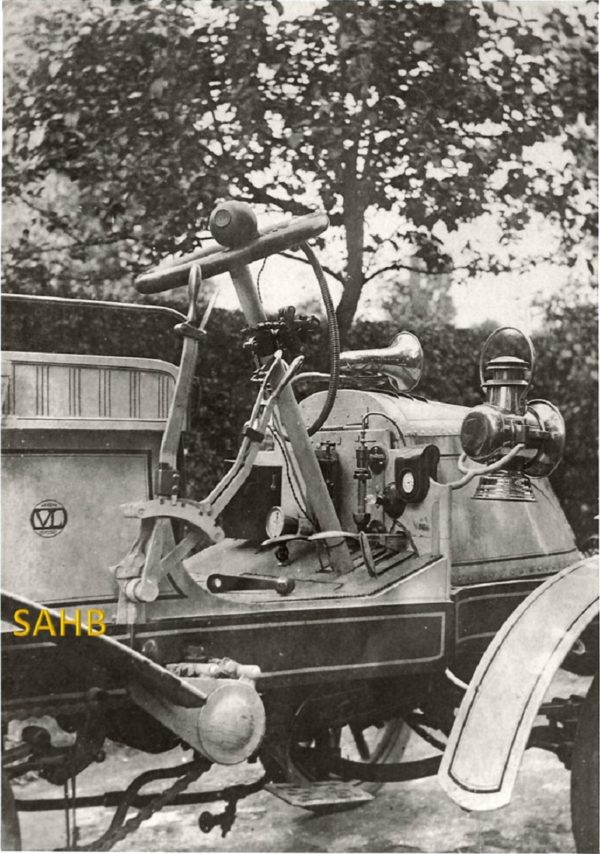
Photographs of cars taken in the very early days most commonly are ‘set-piece’ images from professional photographers that show the proud owners posing with their vehicle. Photographs showing detail of the same car are rare, and therefore all the more interesting. This photograph showing the controls of a veteran car is a fine example. It would take a real expert to identify the make of the car from what is visible in this restricted view, but, as it came accompanied by a few other photographs taken at the same location on the same occasion that show the whole car, we can reveal that it was a Véhel, made in Paris. This obscure marque ceased production in 1902 and one can surmise that our example was built little, if any, earlier than that year.
Nick Georgano’s The Beaulieu Encyclopaedia of The Automobile, the ultra-comprehensive 2-volume magnum opus published in the year 2000, tells us in the briefest of entries that the makers, active from 1899, were Messrs. M & A Dulac: 6hp single- and 8hp twin-cylindered models were offered, final drive was by side chains from a 3-speed gearbox, and some examples were imported into Britain and marketed here as ‘Torpedo’ cars. As to which size of engine is under that aggressively-pointed bonnet, we admit ignorance.
Consulting a French dictionary in quest of a reason for the choice of ‘Véhel’ as the brand name for Dulac’s cars gives no better an explanation than some similarity with the French word ‘véhicule’. A monogram, probably in the form of a transfer that has been applied to the side of the bodywork below the driver’s seat, reads ‘VL’, this in a circle with the words ‘marque’ and déposé’ (trade mark) in small lettering above and below.
Over-restoration of veteran cars, with excessive lining of brightly-coloured paintwork, is a commonly-made criticism of some entries in the annual London to Brighton Veteran Car Run. This Véhel is evidence that fancy finishes were an original option for cars at this period, echoing the turnout of many horse-drawn carriages and traps. The paraffin side-lamps are the larger type then current, which called for stronger and more effective forked brackets, rather than the single-sided ‘spade’ fixing adequate for smaller ones. We can see the locking catch engagement of the gear lever, the more upright one, which signifies the sequential quadrant type of change arrangement. The handbrake lever was usually pushed forwards for braking at this period.
Whilst the centre and left pedals are ‘piano’ push-down type, what probably is the accelerator pedal to the right is an organ-type, pushed forwards, not down. Early cars were often driven mainly on the ignition timing, so the pedal is an advanced feature and the small lever on a quadrant mounted on the steering column most likely serves to vary the advance of the spark. The steering wheel seems devoid of any levers, merely ornamented by the rubber horn bulb, and the horn itself is a somewhat orchestral accessory. Completing the devices that call for the driver’s attention are what appears to be an adjustable drip-feed lubricator, the wooden box for the ignition trembler coils, and, finally, a watch-like timepiece clamped to the dashboard in a leather carrier.
Suggestions are welcome for the purpose of the gauge just above the floor – maybe it records air pressure if the fuel supply is not the more usual method of gravity. Likewise the electrical wiring down the steering column: maybe that controls on-off for the ignition. Awaiting the resumption of the journey, the starting-handle can be seen, lying on the floor. Driving a modern car is infinitely more simple!
This is the second of the Snapshots generously provided by the late John Warburton before his passing in January 2020. We publish it in tribute to an exceptional man.







John Warburton and I had regularly contact on early car issues, so it’s hard to realise that I’ll never be able to rely on his vast knowledge again. However in spirit he will be a support for me forever!
It is interesting to read about this Véhel, at the time raising some interest in the press, but forgotten now completely. The car was shown at the Paris Salon early 1901 and The Autocar of Februari 16th, 1901 described the car in some detail. As to the gauge the text read: “The driver has before him a glass tube in the form of a gauge connecting the water tank with the motor, so that he can always see if the pump is working.”
The name Véhel probably was short for Voiture Légère, as the car was referred to ‘voiture automobile légère’ in the adverts. In 1899 the engineers M. and A. Dulac already built an even smaller car, the Dulac, which had a similar front.